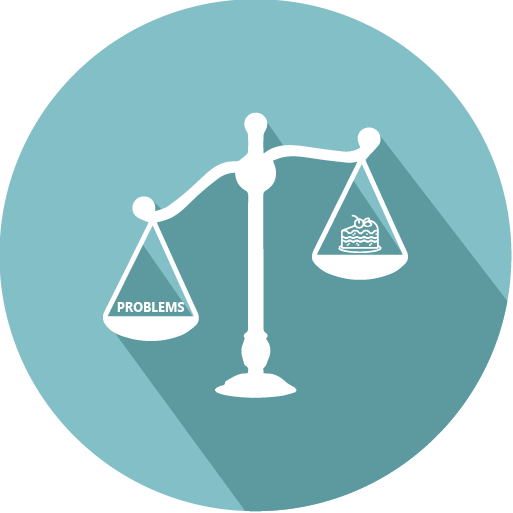Is Fondness for Roundness a thing? How to increase buying intentions for indulgence foods with a basic shape
Relevant topics Archive, Strategy
Think about two similar scenarios where you want to treat yourself. One: you just left the gym after a long day. It was a good session. You ate your frog and managed to tick almost everything off your list. You have a hankering for something good to say “You did well today”.
Two: you just left the office, it’s late in the evening and you want a little pick me up. Another day at the office, a lot of overtime with little moments of reflection. You rarely have time for yourself, but you are the best at your job, and you love it. You want something good to ease your relaxation and end the day.
What do you pick in each of them? A chocolate cheesecake sounds just as good as a pack of graham crackers. You will say: “My choice can come down to many things! My plans for the evening, the package and its colors, how, and if it smells. Should I go on?”. Well, yes and no.
The interest in how and why we consume specific foods is not a novelty. Researchers show how the shape of the packaging, the font, colors, its placement, and other cues play important roles in consumers’ food evaluation and choice (e.g., Simmonds et al., 2019; Spears et al., 2016; Westerman et al., 2012). We know how the different ingredients, textures, and cultural background creates abundant niches in today’s consumer’s preferences. We look for a complex experience and we enjoy making the trip. But this simple food feature- the round shape, is gaining attention for its purchasing implications. And more importantly, for well-being opportunities.
The latest research in consumer’s food choices of Zhou Shoujiang and colleagues shows how the food’s shape is a central factor in our decision-making process. More exactly, the round shape of a product provides us with affective information and influences how we see the product, what we choose, and why. It is called the Round-Shape Preference effect and is shaping our buying habits.
Not all round shapes come in equal preferences
Researchers established the Round-Shape Preference effect to stem from our evolved fear response (e.g., Bar & Neta, 2006, 2007; Westerman et al., 2012) and our cultural experiences (Gómez-Puerto et al., 2016).
Our fondness for round shapes is not really a novelty. Our attraction for round shapes is evolutionary and natural. We've slowly attached ourselves to the softness and perceived safety of what a round shape means. Sharp animal teeth and hard angular rocks stand either for danger or unpleasantness. As opposed to a delicious apple, or a curvy, healthy, individual to choose as a mate. The occurrence of circles in nature is also abundant. Amongst our first deities, we celebrated the Sun and the Moon - safety, warmth, and life. Research shows that our brains need to spend less power analyzing smooth, round surfaces. So, it is only normal to notice them first.
Psychological research around food shows how a round shape creates pleasant sensory reactions and is often associated with hedonic foods. (Liang et al., 2013; Velasco et al., 2015). And today, studies show that food shape has a definite impact on consumers’ affective states, subsequent product evaluation, and decisions. (Zhou et al., 2021).
The study also brings evidence that shows we decide what to eat based on how we feel in the moment. If we are enticed by positive feelings and presented with something to satisfy our visual and emotional needs, we will most likely choose that.
But not all consumers are made equal. The study explains a big difference between two very different types of consumers- people with low and high health motivation. The latter will not be influenced by shape, color, or the store music. Here lies the distinction between hedonic food (chocolate, pastry, or candies) and practical food (fruit, veggies) for these two groups. More exactly, people with a high health motivation will not have a hedonic fueled reason to buy food. Thus, they will be less emotional when making a decision. They have clear goals and will choose accordingly.
For people with lower health motivation, a round hedonic product will be more appealing than its angular one. While in the case of utilitarian food, the shape makes no difference. A salad is what it is. A donut, on the other hand...
Should we all start making round chocolates?
The Round-Shape Preference effect has the power to overcome important qualities when we make a purchase. Age, purchasing frequency, how hungry we are, or the food’s warmth seem to be surpassed by its shape. However, the researchers found that warm and pleasantly colored food is the preferred choice, regardless of the shape it comes in. And it makes sense. We want to buy food that is appealing to us and can satiate our hunger.
Although previous studies in advertising and psychology provided insights about the shape cue in food products, some studies confirm the reverse effect. But this research shows that the offset is coming from consumers with active health goals.
Applied shape-science
This is a useful finding from the design board and straight to the shelves. When designing and marketing hedonic foods, consider using a round or an angular shape. This will influence your consumers’ preferences and consumption. Although, the round shape evokes more positive emotions overall.
We know that hedonic foods can be made more appealing to consumers. But the opposite is also true: sweet and salty snacks can be designed in a shape that will decrease their attractiveness, to those with low health motivation.
It goes without saying that we want our food to be appealing, delicious, tempting even. But making it so and just creating the illusion of vitality, and actual well-being are two different things.
Ultimately, the people who want to have cake will have it. And justify having it. Because it’s not just the shape, smell, or color of food that exclusively makes the purchasing choice. We are more complex than that. In either scenario, maybe one night you will choose the crackers, and the next, you take home an entire chocolate cheesecake. But because we understand how this plays a part and is also an opportunity to educate customers towards positive purchasing habits.
Frank Bruni, a former New York Times restaurant critic said that “food is an aspect of culture that, because everyone necessarily participates in it to some degree, is more egalitarian than, say, ballet, or opera, or even theater. It's easier and less intimidating to join the fray and weigh in with an opinion” (Haskell, 2010).
This is a time when it is easier for all of us to weigh in with informed opinions and better products. This is a way to help people lead healthier lives and contribute to mass well-being. As food is a central part of what fuels us organically and emotionally, it is a way to bring more satisfaction into our customers’ lives.
Take-Home Points
- The round shape of a hedonic food influences consumers' preference and consumption
- When taking into account the different variables examined by the researchers (gender, age, how hungry we are, how often we buy food, or how warm it is) we all fall for the shape preference in all cases.
- However, the Round- Shape Preference Effect does not apply to people with high health motivation because they are actively pursuing a state of well-being.
- This is an opportunity for food designers & manufacturers to increase the appeal of hedonic foods to increase sales
- To create a positive impact on well-being, food designers and manufacturers can control the overconsumption of hedonic foods by choosing a less appealing shape.
Further Reading
-
Justifying Indulgent Choices: The Role of Deservingness in Consumer Decisions
Whether it’s New Year’s resolutions or another self-made commitment, individuals face a daily barrage of goal conflicts. Granola bar or brownie? Gym or another Netflix binge? Scroll social media or pick up a good book?
Conflicts of goals occur when a person must choose between pursuing long-term goals or succumbing to indulgences. And it turns out, willpower isn’t the only factor.
While it might seem easy to choose a healthier option, especially knowing there’s a weight-loss or healthy goal attached to it for example, studies have found that self-control failure is higher when there’s a meaningful reason to justify the indulgence.
In other words, give yourself a good reason and you’ll choose the indulgence nearly every time.


